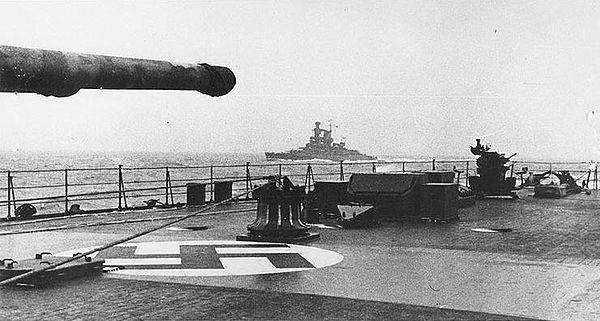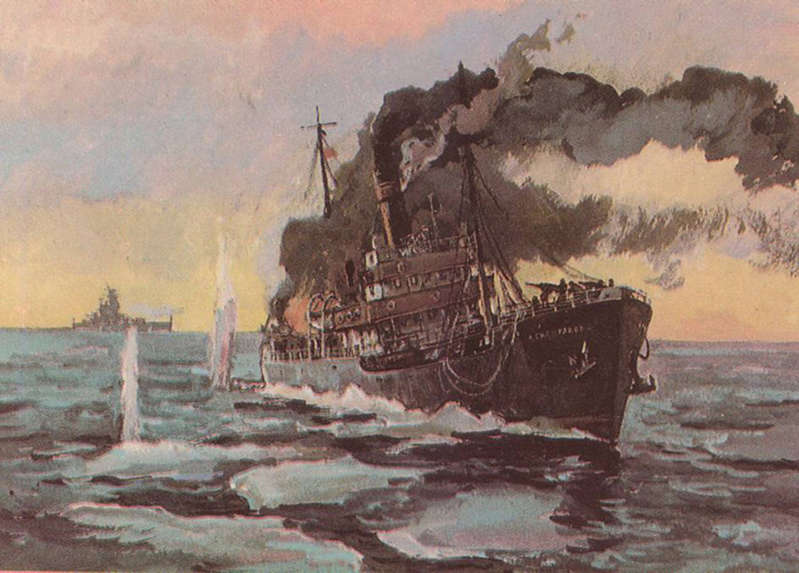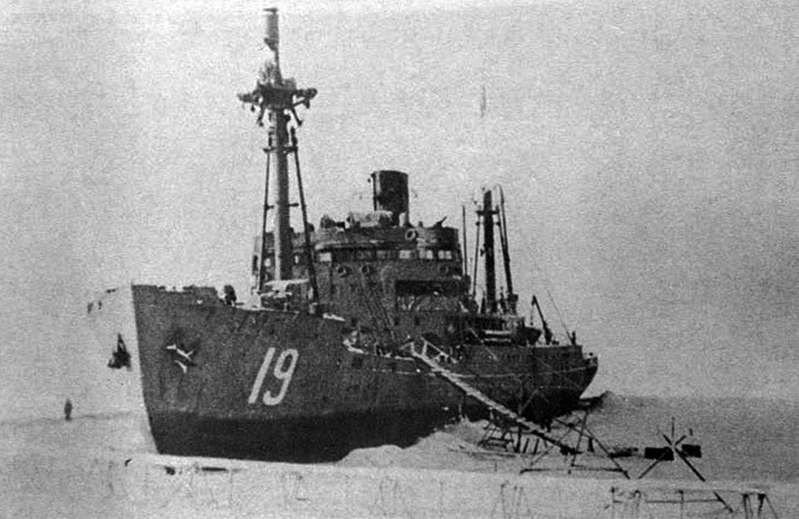In 1942, in the Kara Sea, German planning collided with Russian improvisation.
Attack plan
Operation “Wunderland” (“Wonderland”) in the Kara Sea, according to the plan of the command of the German fleet, was to block navigation in the Soviet Arctic – to destroy the ports of the Northern Sea Route and destroy the eastern convoys of the allies.
The calculation was based on the fact that the Soviet Navy did not expect an attack in the Kara Sea, the ports and convoys were poorly protected and would not be able to resist the German heavy cruisers Admiral Scheer and Lyuttsov. However, the latter, during Operation Knight's Ride (the infamous destruction of the PQ-17 convoy), hit an underwater rock and was unable to take part in the campaign.

Only the cruiser “Admiral Scheer” went to the Kara Sea, which was reinforced with seven submarines: three of them conducted reconnaissance and attacked Soviet ships and bases, diverting the attention of the command of the Northern Fleet, and four covered the ship.
Having received information from the Japanese in August 1942 that a large convoy had left Petropavlovsk-Kamchatsky and passed through the Bering Strait, the Admiral Scheer launched an operation, hoping to intercept it in the Kara Sea at the end of August.
Chasing a ghost
The bold plan was based on incorrect calculations: because of the ice in the Laptev Sea, the convoy moved slowly and arrived in the Kara Sea only a month later. The Germans generally did not know this sea area well and were going to rely on air reconnaissance data and radio intercepts, for which a radio reconnaissance group under the command of Captain Disterweg, most of whose members spoke Russian, joined the Sheer crew.
However, they were unlucky at once with aerial reconnaissance: both BV.138 seaplanes, capable of staying in the air for up to 12 hours without refueling, were out of order. The captain of the Scheer had only one seaplane left, the weaker Arado, but it also crashed on 25 August while landing.
By this time, the Germans already understood that something had gone wrong. There was no Allied convoy in the Kara Sea, from time to time a submarine or the Arado plane was noticed by some ships, which they mistook for a convoy. Sheer was chasing them, but, not having enough information about the situation with the ice fields, she was almost caught in the ice off the Russkiy Island.
Icebreaking steamer “Alexander Sibiryakov”

After that, the captain stopped “chasing the ghost”, and the cruiser began to retreat to the west. And here the Germans were lucky for the first time: they met the old icebreaking steamer “Alexander Sibiryakov”, which was taking a shift from Dikson to the polar stations of Severnaya Zemlya.
The Scheer's captain, Wilhelm Meendsen-Bolcken, could have sunk it quickly, even before the steamer reported a meeting with the cruiser by radio, but he desperately needed information on ice conditions and convoy movements that he could get from the Russians. Therefore, the Germans tried to deceive the crew of the Sibiryakov: they raised the American flag, introduced themselves as the heavy cruiser of the Tuscaloosa and sent a radio message in Russian: “Who are you and where are you going? Report ice conditions in the Vilkitsky Strait ”. At the same time, either a Russian or a German radio operator was mistaken: the ship took the name of the ship not as “Tuscaloosa”, but as the Japanese “Sishiyama”.
A Japanese ship flying an American flag negotiating in Russian in the Kara Sea? The captain of the Sibiryakov immediately sent a warning to the headquarters of the Northern Fleet, and Operation Wonderland was no longer secret. The headquarters ordered to open fire on the enemy. The last words of the radio operator from “Sibiryakov” were: “Well, the cannonade has begun,” after which the connection was cut off. Twenty minutes later, a radio message was broadcast: “We are on fire, goodbye” – and the ship was silent forever.
The icebreaker, armed with several weak cannons, took a fight with the heavy cruiser and an hour later was sunk by her own crew after several hits of large-caliber shells. The Germans removed 21 or 22 sailors from the boats (Soviet and German data differ here). Many of them did not want to surrender and offered resistance to the Germans.
By order No. 103 of the commander of the Northern Fleet dated April 28, 1965, the ships passing in the area of Belukha Island, where the icebreaking steamer Alexander Sibiryakov died, are obliged to lower the flag and thereby honor the memory of the hero steamer.
Doomed island
Having lost the effect of surprise, the captain of the Sheer also lost hope of finding the ever elusive convoy from Petropavlovsk-Kamchatsky. Now the idea of attacking the port looked much more promising, where it was possible to capture headquarters, senior commanders, maps, naval codes and other valuable information.
Dixon was chosen as the target, as Captain Diesterweg's team, after analyzing Soviet radio traffic, concluded that Dixon acts as the center of the radio network, which means that a large enemy headquarters is located there. The seizure of the port could disrupt navigation in the Soviet Arctic, and Operation Wonderland would have been a success despite all previous setbacks.
Dixon was completely unprepared to repel the attack. At the end of the summer of 1941, the port's defenses were reinforced by several coastal batteries, but the diverting attacks of German submarines a month before the Admiral Scheer went to sea did their job: the command of the Northern Fleet ordered the transfer of guns to Belushya Guba. For this, an auxiliary military ship SKR-19, the former icebreaker “Semyon Dezhnev”, arrived at the port. At the time of receipt of the message from the Alexander Sibiryakov, two of the three batteries had already been loaded, and only two heavy 152-mm guns of 1910 were on the shore.
Despite the warning, the Soviet command did little to fend off the threat. More precisely, a lot was done at the headquarters of the Northern Fleet: the commanders discussed, planned, wrote and sent orders and counter-orders, but the Soviet control and communications system was so cumbersome that the implementation of the proposed measures would take months, if not years. And the bill went to hours.
Defense plan
The sluggishness of the Soviet command system, as usual, was compensated by the initiative of the executors. The battery commander, Lieutenant Nikolai Kornyakov, without asking permission from anyone, ordered the shells to be unloaded from the barge back to the pier and recruited volunteers from local loaders to gun crews for his 152-mm guns.
The Germans planned to carry out a “shocking” shelling, and then land a landing team of 180 submachine gunners, which would capture the village. The Dikson residents did not have a defense plan at all. Everyone understood that they had nothing to oppose the firepower of a heavy cruiser, they could only count on giving their lives more expensive.
Icebreaker “Semyon Dezhnev”

Semyon Dezhnev came out to meet “Admiral Scheer”. It was pure self-sacrifice: the crew decided to hold back the cruiser as long as they could, and then flood in the fairway, blocking its path. Approaching the enemy for four nautical miles, the captain of “Semyon Dezhnev” insolently demanded that the cruiser identify himself. The answer was a volley of armor-piercing shells that easily pierced through the hull of the old icebreaker. The Germans realized their mistake, replaced the shells with high-explosive fragmentation and with the third salvo took Dezhnev out of the battle: the ship began to sink before reaching the intended place where it was possible to block the fairway.
The defenders of Dixon had no more opportunities to stop the cruiser.
Coastal battery
And then the battery of Lieutenant Nikolai Kornyakov began to fire. The shots were inaccurate: the nearest shell fell into the sea 600 meters from the cruiser. But the captain of the Scheer was seriously concerned about these large-caliber shells.
Captain Wilhelm Meendsen-Bolcken did not know how many guns the Russians had at their disposal and where they were. He admitted that the first shots were only sighting, and feared that the next would be more accurate. Was it worth it for a lone cruiser a thousand miles from the base to start a frontal battle with coastal batteries, most likely heavily camouflaged, protected by plate armor and hidden somewhere in the rocks?
The captain of the Admiral Scheer decided to retreat.
The Germans did not know that they were dealing with two old siege weapons of the First World War, standing in the open air, without armor and camouflage, shooting blindly through smoke and fog, without rangefinders and observation posts, served by crews of loaders under the command of an inexperienced lieutenant.
The captain of the “Admiral Scheer” decided not to risk it and first to destroy the entire port with artillery fire from a long distance. The next hour, the cruiser slowly moved along the coast and destroyed everything. Soon a weather station, a power station, a radio center, oil and coal terminals, and residential buildings in the village were on fire on Dikson.
The head of the local airport, N. Collo, armed with a light machine gun with a single disc, with the support of a friend who had a rifle with one clip, ran after the cruiser along the entire coast to prevent the landing. The peasants were very lucky that the Germans nevertheless abandoned the idea of a landing: N. Kollot and his comrade had no chance to resist the boats with machine guns and submachine gunners.
All this time, Kornyakov's battery responded to the Germans, focusing on the sound of shots and distant reflections. Naturally, there was not a single hit, but the Germans noted that the Russian battery was still not suppressed.
Bomber squadron
Here the captain of the heavy cruiser was given a headache by the radio operators of Captain Disterweg. They reported on the radio interception: they requested aviation support from the island, and the pilot replied that the bomber squadron would arrive in 30 minutes. An air attack could be fatal for the cruiser, and the Admiral Scheer, setting up a smokescreen, left for the Kara Sea.
In fact, there was no squadron of bombers, a random single plane flew to Dixon, the pilot of which understood everything and supported the radio operator from the island.
The Arctic really became a wonderland that day: the heavy cruiser Admiral Scheer, the beauty and pride of the Kriegsmarine, Germany's most successful ship in World War II, flew in front of two antediluvian Soviet cannons and one mythical squadron.
Related materials:
- Burnt in Concrete: The Immersive History of Fort Drum
- The Spy Who Loved Himself: The Story of Eddie Chapman – Double Agent, Smuggler, Swindler and Womanizer
- Crippled warrior. Gallant biography of General Adrian Carton de Viart
- What concrete ships look like. Yes, the real ones, not the layouts
- The story of how 15 ships were stuck in the Suez Canal for 8 years

